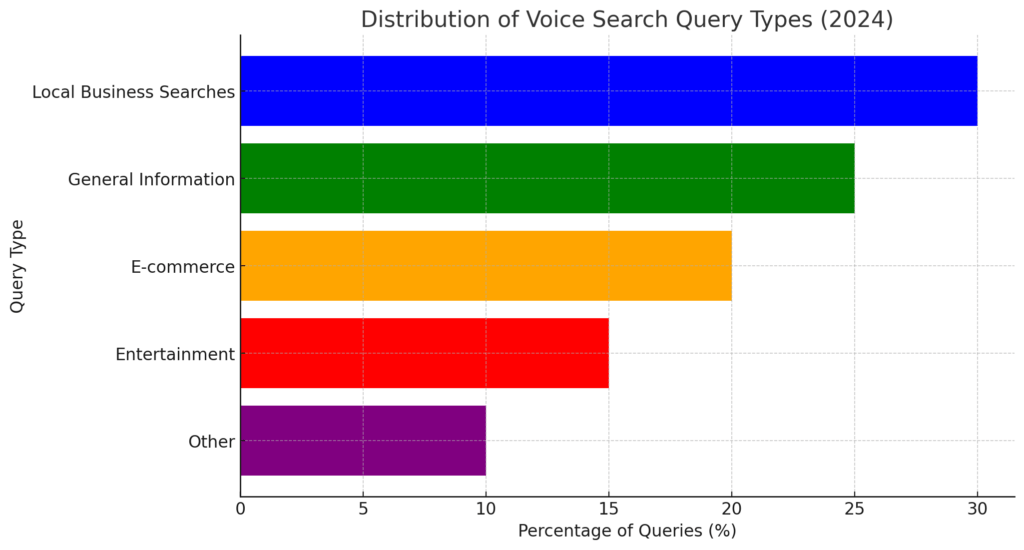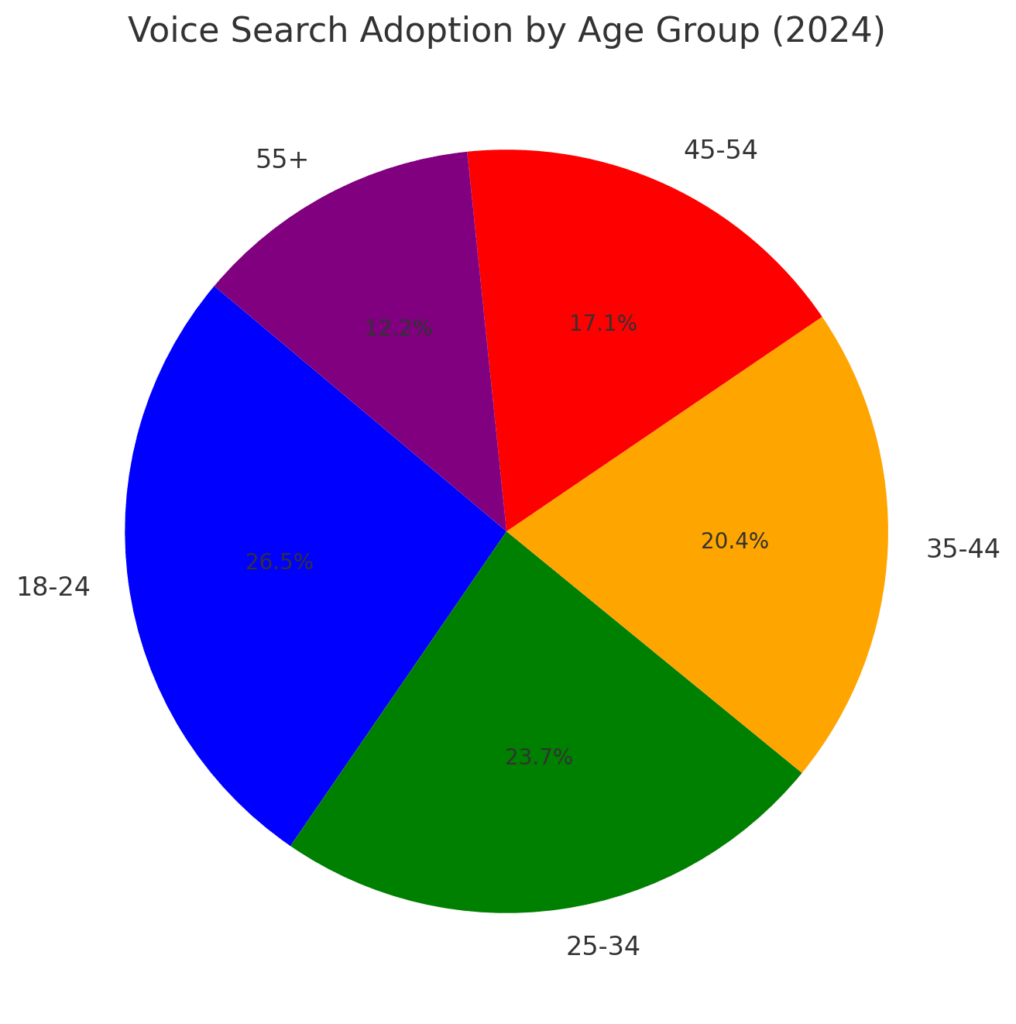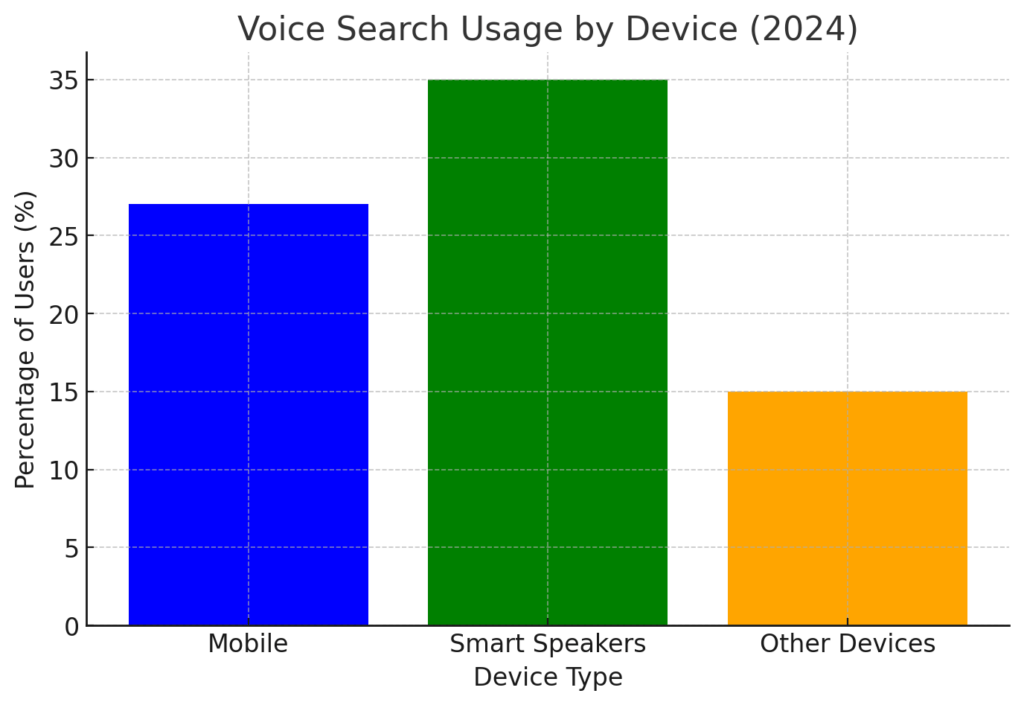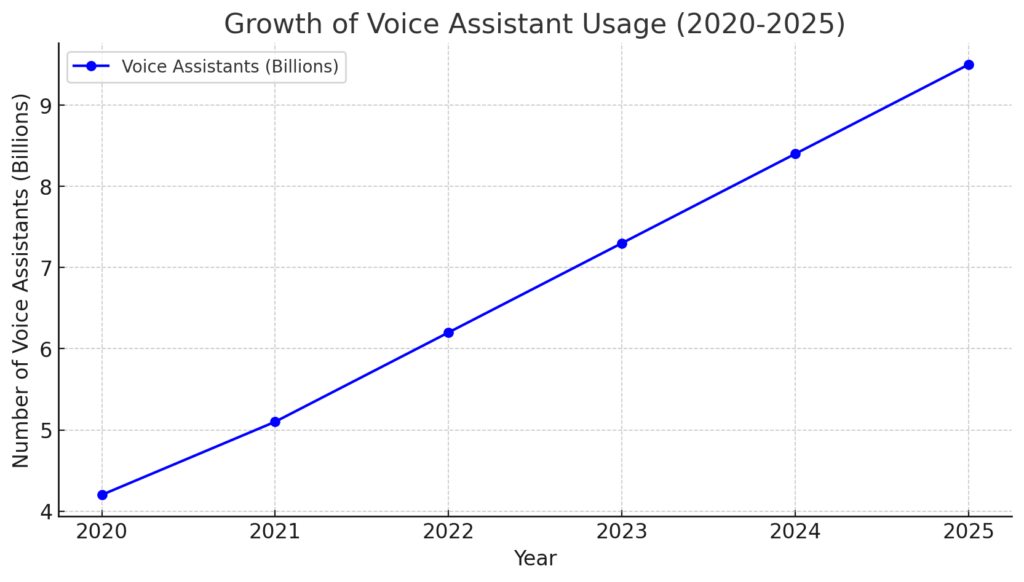
23 Mar BEST VOICE SEARCH STATISTICS 2025
Voice search has transformed the way people interact with technology, making it faster and more convenient to find information, shop, and complete tasks hands-free. With AI-powered assistants like Google Assistant, Siri, and Alexa becoming more advanced, voice search is no longer a novelty but a fundamental shift in user behavior. Businesses must adapt to this growing trend by optimizing their content for spoken queries, as voice search presents new opportunities—and challenges—for digital marketing, e-commerce, and local SEO. As adoption rates rise, industries across the board will need to rethink how they engage with consumers who increasingly prefer voice over text-based interactions. Amra and Elma gathers the statistics below to highlight the rapid expansion of voice search, its impact on various sectors, and what the future holds for voice-enabled technology. Understanding these trends will be essential for businesses and marketers looking to stay ahead in an increasingly voice-first world.
BEST VOICE SEARCH STATISTICS 2025 (Editor’s Choice)
Voice search technology has experienced significant growth over the years and is projected to continue its upward trajectory through 2025. Here are 20 of the most compelling voice search statistics, reflecting both historical trends and future projections:
1. Global Voice Assistant Usage: The number of voice assistants in use worldwide is projected to reach 8.4 billion by the end of 2024, nearly doubling from 4.2 billion in 2020.
2. Voice Search Adoption: Approximately 20.5% of the global population now uses voice search, marking a slight increase from 20.3% in early 2024.
3. Mobile Voice Search: 27% of the global online population utilizes voice search on mobile devices, highlighting its integration into daily mobile usage.
4. U.S. Voice Assistant Users: In the United States, the number of voice assistant users is expected to reach 153.5 million in 2025, up from 142 million in 2022.
5. Smart Speaker Ownership: 35% of U.S. adults own a smart speaker, indicating a substantial market penetration of voice-activated devices.
6. Voice Search for Local Businesses: 58% of consumers have used voice search to find local business information, emphasizing its importance for local SEO strategies.
7. Voice Commerce Growth: Voice commerce transactions are projected to reach $80 billion annually by 2023, reflecting a significant shift in consumer purchasing behavior.
8. Voice Search Result Speed: Voice search results load 52% faster than average search results, with pages loading in approximately 4.6 seconds.
9. Accuracy of Voice Assistants: On average, voice assistants can answer 93.7% of all search queries accurately, showcasing advancements in natural language processing.
10. Voice Search Length: The average voice search query is between three to five words, indicating a preference for concise, specific inquiries.
11. Daily Usage Among U.S. Adults: 41% of U.S. adults use voice search daily, underscoring its integration into routine activities.
12. Youth Engagement: 55% of U.S. teens utilize voice search daily, highlighting its popularity among younger demographics.
13. Voice Search in E-commerce: Approximately 13.6% of the U.S. population uses smart speakers for shopping-related activities, such as researching products and adding items to shopping lists.
14. Smart Speaker Market Value: The global smart speaker market is valued at $11.9 billion, reflecting the growing consumer interest in voice-activated technology.
15. Voice Search and Local Intent: 46% of all Google searches are seeking local information, and voice search plays a significant role in these queries.
16. Voice Search in the Car: 62% of U.S. drivers have used voice assistants while driving, indicating the convenience and safety benefits of hands-free technology.
17. Voice Search and Multitasking: 52% of people keep their voice-activated speakers in their living rooms, allowing for multitasking while accessing information or entertainment.
18. Consumer Satisfaction: 93% of consumers are satisfied with their voice assistants, citing benefits like multitasking, instant answers, and simplified lives.
19. Voice Search and SEO: Featured snippets account for 40% of voice search results, emphasizing the importance of structured data and concise information in SEO strategies.
20. Future Projections: By 2025, it is anticipated that 75% of households will own smart speaker devices, indicating a significant shift toward voice-enabled technology in daily life.
These statistics underscore the rapid adoption and integration of voice search technology across various aspects of daily life and business, highlighting the importance for organizations to adapt their strategies accordingly.

BEST VOICE SEARCH STATISTICS 2025 and Future Implications
BEST VOICE SEARCH STATISTICS 2025 #1. Global Voice Assistant Usage:
The number of voice assistants in use worldwide is expected to reach 8.4 billion by the end of 2024, surpassing the global population. This rapid expansion shows how voice technology is becoming an integral part of daily life, from smart speakers to mobile assistants like Siri and Google Assistant. As adoption increases, businesses will need to optimize their content for voice search to maintain visibility. The rise in usage also means companies will need to develop voice-friendly interfaces for e-commerce and customer service. Additionally, privacy concerns may grow as more devices constantly listen and process data. Regulatory changes could impact how voice data is stored and used in the coming years. The future will likely see even more seamless integration of voice assistants into smart homes, workplaces, and even automobiles.
BEST VOICE SEARCH STATISTICS 2025 #2. Voice Search Adoption:
About 20.5% of the global population uses voice search, showing steady growth from previous years. While this percentage may seem moderate, it represents hundreds of millions of users worldwide. The continued adoption suggests that people find voice search more convenient than traditional text-based searches. This trend will push businesses to refine their SEO strategies, focusing on conversational and long-tail keywords. As AI improves, voice search accuracy and understanding of different languages and accents will also enhance. In the future, we can expect more advanced personalization, where voice assistants remember user preferences and deliver more relevant results. Additionally, brands that fail to adapt may lose visibility in search engine rankings.
BEST VOICE SEARCH STATISTICS 2025 #3. Mobile Voice Search:
Mobile voice search is used by 27% of the global online population, highlighting the shift toward hands-free interactions. Smartphones have made voice search accessible on the go, making it particularly useful for quick queries and local searches. This statistic indicates that brands must optimize their mobile websites for voice queries, ensuring fast-loading pages and clear, concise answers. As more users turn to voice search, digital marketing strategies will need to evolve, prioritizing spoken language patterns over traditional keyword-based content. The growing reliance on voice search will likely influence app development, with more applications integrating voice-activated features. This also means mobile advertising may shift towards voice-enabled ad placements. In the future, advancements in AI-driven voice recognition will make voice search even more intuitive and responsive.
BEST VOICE SEARCH STATISTICS 2025 #4. U.S. Voice Assistant Users:
The number of voice assistant users in the U.S. is projected to reach 153.5 million in 2025, up from 142 million in 2022. This increase highlights the growing reliance on digital assistants for everyday tasks, from setting reminders to answering questions. As more users engage with voice assistants, businesses will need to tailor their content to voice-driven platforms like Google Assistant, Alexa, and Siri. Customer service will also see a transformation, with AI-powered voice bots handling inquiries more efficiently. The widespread adoption may lead to new marketing opportunities, such as personalized voice-based promotions. With more people using voice search for shopping, e-commerce platforms will need to enhance their voice commerce capabilities. Looking ahead, improved AI will allow voice assistants to understand context better, making them more conversational and lifelike.
BEST VOICE SEARCH STATISTICS 2025 #5. Smart Speaker Ownership:
About 35% of U.S. adults own a smart speaker, signifying the deep penetration of voice technology into households. These devices have changed how people interact with technology, replacing traditional search methods with voice commands. The increasing adoption of smart speakers suggests that brands should consider voice-optimized content, such as audio blogs and voice-based advertising. As voice commerce grows, businesses will need to streamline the purchasing process for voice transactions. Smart home integrations will become more sophisticated, enabling seamless control over various devices. However, privacy concerns surrounding voice recordings and data security may lead to stricter regulations. In the coming years, smart speakers will likely feature enhanced AI, allowing for more natural conversations and personalized responses.

BEST VOICE SEARCH STATISTICS 2025 #6. Voice Search for Local Businesses:
Around 58% of consumers have used voice search to find local business information, reinforcing its importance in local SEO. Many users rely on voice search for quick access to store hours, directions, and product availability. This trend means businesses must ensure their online listings are accurate and optimized for voice queries. Voice search-friendly websites with structured data and location-based keywords will rank higher in results. The future of local marketing will be heavily influenced by voice technology, with businesses integrating AI chatbots for instant voice interactions. Additionally, voice search will play a larger role in restaurant reservations, appointment bookings, and service inquiries. As the technology improves, voice search may become the primary way consumers engage with local businesses.
BEST VOICE SEARCH STATISTICS 2025 #7. Voice Commerce Growth:
The voice commerce market is projected to reach $80 billion annually, highlighting the shift in how consumers shop. This growth reflects the increasing trust in voice transactions, with users ordering products and services through Alexa, Google Assistant, and Siri. Retailers must optimize their e-commerce platforms for voice search, ensuring a seamless checkout experience. Personalized shopping experiences will become more common, with AI analyzing past purchases to make voice-based recommendations. Security measures will need to evolve to protect consumers from fraudulent transactions. The adoption of voice commerce may also lead to more partnerships between retailers and tech companies to improve voice-driven shopping experiences. In the future, voice-enabled payments could become standard, making shopping faster and more convenient.
BEST VOICE SEARCH STATISTICS 2025 #8. Voice Search Result Speed:
Voice search results load 52% faster than traditional search results, which impacts user experience and SEO rankings. The speed advantage makes voice search an attractive alternative to text-based searches, especially for quick answers. This trend will push businesses to optimize their websites for fast-loading content, improving their chances of being featured in voice search results. Google prioritizes websites with structured data and concise, direct answers, making it crucial for brands to adapt their content strategies. As voice search grows, search engines may introduce new ranking factors specific to spoken queries. Faster response times will enhance user satisfaction, leading to greater adoption of voice search technology. Over time, AI improvements will further refine the accuracy and speed of voice-driven responses.
BEST VOICE SEARCH STATISTICS 2025 #9. Accuracy of Voice Assistants:
Voice assistants can answer 93.7% of all search queries correctly, demonstrating improvements in natural language processing. Higher accuracy rates make voice search more reliable, encouraging further adoption. Businesses will need to refine their digital content to align with AI-driven responses, ensuring their information is easily accessible. As accuracy improves, users may rely on voice assistants for more complex tasks, such as financial planning and medical advice. AI advancements will lead to better contextual understanding, making voice assistants more conversational. This trend may reduce the need for traditional search engines, shifting user behavior towards voice-first interactions. In the future, voice assistants may become indistinguishable from human conversations, enhancing their usefulness.
BEST VOICE SEARCH STATISTICS 2025 #10. Voice Search Length:
The average voice search query is between three to five words, indicating a preference for brief, direct questions. Unlike text searches, which often include fragmented keywords, voice queries are conversational and natural. This trend requires businesses to optimize their content for long-tail, spoken phrases rather than short keywords. Featured snippets and structured data will play a crucial role in ensuring content ranks for voice searches. The rise in voice search length means that AI must improve its ability to understand context and intent. Over time, voice search algorithms will likely prioritize responses that mimic human speech patterns. As people grow more comfortable using voice search, queries may become even longer and more complex, pushing AI to provide more detailed responses.

The Future of Voice Search: What’s Next?
Voice search is no longer an emerging trend—it’s a fundamental shift in how people access information, interact with technology, and make purchasing decisions. As adoption rates continue to rise, businesses that optimize for voice search will gain a competitive edge, while those that ignore it risk falling behind. The growing accuracy of AI-powered assistants and the expansion of smart speaker ownership indicate that voice-driven interactions will become even more natural and seamless. Industries such as e-commerce, local business services, and customer support will need to prioritize voice-friendly content, ensuring they meet the needs of a voice-first audience. At the same time, advancements in personalization and predictive AI will make voice assistants even more integral to daily life. As we move toward a future where voice search dominates, businesses that embrace this transformation will be better positioned to engage with consumers in a way that feels intuitive, conversational, and convenient.
Sources:
- https://www.yaguara.co/voice-search-statistics
- https://www.yaguara.co/voice-search-statistics
- https://bloggingwizard.com/voice-search-statistics
- https://www.yaguara.co/voice-search-statistics
- https://www.webfx.com/blog/seo/voice-search-trends
- https://www.synup.com/en/voice-search-statistics
- https://www.synup.com/en/voice-search-statistics
- https://searchendurance.com/voice-search-statistics
- https://bloggingwizard.com/voice-search-statistics
- https://kommandotech.com/statistics/voice-search-statistics
- https://bloggingwizard.com/voice-search-statistics
- https://bloggingwizard.com/voice-search-statistics
- https://www.demandsage.com/voice-search-statistics
- https://kommandotech.com/statistics/voice-search-statistics
- https://www.synup.com/en/voice-search-statistics
- https://www.invoca.com/blog/voice-search-stats-marketers
- https://www.invoca.com/blog/voice-search-stats-marketers
- https://www.invoca.com/blog/voice-search-stats-marketers
- https://www.yaguara.co/voice-search-statistics
- https://www.invoca.com/blog/voice-search-stats-marketers


